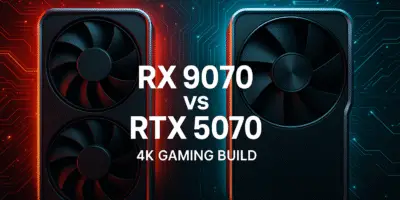Hey there, tech enthusiasts! Today I’m walking you through my latest compact PC build featuring the new RTX 5070 Ti graphics card. This build was actually supposed to happen last week, but you know how things go—sometimes parts don’t arrive on schedule and plans get delayed.
Let me be upfront about something: not every component in this build was my first choice. Sometimes you have to work with what’s available in the market. For instance, I wanted an AMD motherboard, but literally every vendor I talked to said, “We have Intel boards, why do you need AMD? Intel is everywhere! Want the most expensive board? We’ll give you that, just stay away from AMD!” Talk about limited options, right?
Table of Contents
The Component Breakdown
CPU: Core Ultra 5 245K
This Intel processor packs 14 cores with performance cores hitting 5.2 GHz and efficiency cores running at a decent clip too. With 150W power draw, it delivers solid gaming performance and handles content creation well.
Truth be told, it doesn’t represent a huge leap from the previous 13th and 14th generation Intel chips, but there are improvements in power efficiency and thermals that make it worthwhile.
AMD alternatives: If you prefer the red team, consider the Ryzen 7600, 7600X, 9600X, or for serious gaming muscle, look at the 7800X3D or 9800X3D.
Motherboard: ROG Strix Z890-I
This incredibly compact ITX motherboard from ASUS packs almost everything you’d need, with just a couple of limitations you should expect in this form factor. First, you only get two RAM slots instead of four, and second, you’re limited to fewer storage options—just two M.2 slots instead of the four or five you’d find on larger Z-series boards.
Being a ROG Strix board, it does command a premium price, but the rest of the specs are impressive. You get 14-phase power delivery for the CPU, PCIe 5.0 for the graphics card, and the LGA 1851 socket. Important note: this socket only supports 15th generation “Core Ultra” processors, not 12th, 13th, or 14th gen chips—a question I keep getting asked.
The motherboard comes with a cool accessory that adds front panel headers, USB 2.0 ports, and even a PCIe switch to toggle between PCIe generations. For connectivity, you get two Thunderbolt ports and Wi-Fi 7 support.
If you decide to go with AMD, I’d recommend B650 or B850 boards, which will happily support 7000 and 9000 series processors. No need to splurge on X-series boards unless you need specific features or extra M.2 slots.
RAM: XPG Lancer RGB 32GB DDR5-6000
After using these memory sticks extensively and putting them through rigorous testing, I can confidently say they’re excellent—stable, reliable, and compatible with both Intel XMP and AMD EXPO profiles depending on your platform.
CPU Cooler: DeepCool IK620 Digital Pro
This beefy air cooler features a digital display that shows CPU metrics, two sizeable heatsink towers, six heat pipes, and two 120mm fans. It’s substantial, but fits nicely in our case.
Storage: 500GB for OS + 2TB for Games
For storage, I went with a 500GB drive for the operating system and a 2TB drive for games. Kingston’s NV2 or NV3 SSDs offer excellent performance at very reasonable prices—they’re honestly some of the best value storage options available right now.
Graphics Card: RTX 5070 Ti
Now for the star of the show! The RTX 5070 Ti essentially replaces the RTX 4080, delivering about 30% better performance than the 4070 Ti while sporting the same 16GB of memory as the 4080, though it uses GDDR7 instead of GDDR6X.
The performance is stellar, and it comfortably takes the 4080’s place in the lineup. The issue? Price. NVIDIA announced a $750 MSRP, but good luck finding one at that price! The cheapest models start around $900 if you’re lucky, and most are selling for $1,000-1,200. For comparison, the RTX 4080 should theoretically cost around $1,000, making it a better value if you can find one.
Power Supply: ROG Strix 750W Platinum
With the 5070 Ti drawing about 300W and the CPU pulling around 150-160W, a 750W power supply gives us plenty of headroom. Personally, I’d probably go with an 850W unit for a bit more breathing room if this were my daily driver.
The ROG Strix PSU comes fully modular with excellent build quality. It also features a single 16-pin connector for the graphics card instead of using multiple 8-pin adapters, which helps reduce cable clutter in our already tight case.
Case: DeepCool CH110 Mesh
This compact case comes with a mesh side panel, though you can buy a tempered glass panel separately if you prefer showing off your components. I actually preferred the mesh version with the carrying handle on top—it really does feel like a travel suitcase for your PC!
Despite its small size, this case can accommodate massive air coolers like we’re using, or even a 240mm AIO liquid cooler. You can fit either an SFX power supply or a standard ATX unit, though I’d recommend sticking with SFX to avoid cable management nightmares in such a tight space.
The case supports three-slot graphics cards, and our ASUS Prime 5070 Ti just barely fit—I mean literally by a millimeter! If it had been even slightly larger, this build wouldn’t have been possible.
Build Challenges
I did encounter a couple of issues with the case. First, all the panels use standard screws instead of tool-less or magnetic attachments, which would have been much more convenient for a travel-oriented case.
Second, I ran into a strange problem with the power supply orientation. Normally, the PSU fan should face outward, but the cables wouldn’t connect properly that way. I had to flip the PSU so the fan faces inward, which adds heat inside the case—not ideal when everything is already crammed together.
I’m not sure if the issue was with DeepCool’s cable design or ASUS’s power supply port placement, but it could have been easily solved with an alternate angled cable.
Temperature Testing
Initial testing with just one CPU cooler fan was concerning—CPU temperatures hit 93°C with spikes to 96°C, and we were seeing about 2% thermal throttling. After squeezing in the second fan (which was quite a challenge), temperatures dropped significantly to around 81-84°C under full load, with the CPU maintaining its full 5.0 GHz on performance cores and 4.6 GHz on efficiency cores at about 157-160W power draw.
The graphics card temperatures peaked at around 69-70°C while pulling its full 300W power allowance—pretty impressive for such a compact chassis with limited airflow.
Gaming Performance
Let’s talk about what this beast can do in real-world gaming scenarios:
Call of Duty
- 4K, balanced settings (no upscaling): ~125 FPS average
- 1440p, same settings: ~210-215 FPS
- 1080p, minimum settings: ~231 FPS
Cyberpunk 2077
- 4K, Ultra settings with RT and DLSS Quality (no path tracing): ~57-58 FPS
- 4K, Ultra without ray tracing: ~72 FPS
- 1440p with RT and DLSS Quality: ~106 FPS
- 1440p without ray tracing: ~142 FPS
During these tests, the GPU was running at around 2820-2830 MHz core clock, drawing about 270W, while CPU temperatures stayed in the 60-67°C range.
God of War
- 4K, maximum settings without upscaling: ~89-95 FPS
- 4K with DLSS Quality: ~143 FPS
Helldivers 2
- 4K native: ~86-90 FPS
- 4K with DLSS Quality: ~135 FPS
Counter-Strike 2
This was interesting—I encountered strange behavior where the GPU utilization would fluctuate wildly between 2-9% and 48-50%, causing frame rates to bounce between 53 FPS and 250 FPS. I tested multiple times and even swapped in a 4000-series card, which worked fine. This seems to be a driver or game-specific issue with the 5070 Ti.
Hogwarts Legacy
- 4K with DLSS Quality, Multi-Frame Generation (4x), and Ultra Ray Tracing: ~280 FPS average, though with some low 1% lows
Fortnite
- 4K, Epic settings with DLSS Performance and ray tracing: ~90-100 FPS
- 4K, Epic settings with DLSS Performance but no ray tracing: ~115-120 FPS
- 1440p, Epic settings with DLSS Performance and ray tracing: ~189-200 FPS
Final Thoughts
This compact powerhouse turned out incredibly well. Performance-wise, it delivers exactly what you’d expect from a 5070 Ti, which effectively replaces the 4080 with a substantial gap above the 4070 Ti Super.
The issue isn’t with the performance—NVIDIA nailed that aspect—but with pricing. They announced a $750 MSRP but didn’t release a Founders Edition, and partner cards start at $900 at minimum, with most selling for $1,000-1,200. Meanwhile, the RTX 4080 should theoretically sell for around $1,000 but is currently going for about $1,400 due to stock shortages.
My advice? Wait for prices to normalize before jumping on the 5070 Ti bandwagon, unless you can somehow snag one at or close to MSRP.
As for the compact form factor, I’m absolutely in love with it. This little powerhouse with its carrying handle is essentially a “slightly bigger laptop” with extraordinary capabilities. The Core Ultra 5 processor worked well, though you could easily upgrade to an Ultra 9 if needed.
The air cooling solution proved more than adequate and, in my opinion, is a safer choice than liquid cooling for a system that might be moved around frequently. This build would be perfect for a living room gaming setup or for taking to a friend’s place—just grab that handle and go!
What do you think about this compact yet powerful build? Would you consider something this small for your next gaming rig? Let me know in the comments!



